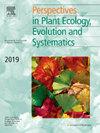Geographical parthenogenesis in tetraploid brambles: Do competition and reproductive output in the secondary contact zone matter?
IF 2.9
3区 环境科学与生态学
Q1 ECOLOGY
Perspectives in Plant Ecology Evolution and Systematics
Pub Date : 2025-02-27
DOI:10.1016/j.ppees.2025.125859
引用次数: 0
Abstract
Apomicts often show geographic distributions different from their sexual relatives, a phenomenon known as geographic parthenogenesis. Traits that have been suggested to influence the likelihood that apomicts and sexuals co-occur include those responsible for resource acquisition and reproductive traits. Here we test the contribution of these traits to geographic parthenogenesis, previously observed in a unique agamic system (Rubus ser. Glandulosi) free from the potential confounding effects of different ploidy. We conducted two competition experiments with different source materials (stem tips, root cuttings) of tetraploid apomicts and sexuals of Rubus ser. Glandulosi from their secondary contact zone to investigate their resource acquisition efficiency and reproductive characteristics. Both apomicts and sexuals were grown in monocultures and in mixtures of both reproductive groups, either with or without an additional competitor (grass Elymus repens). We found no consistent differences in survival, vegetative traits, biomass production or reproductive traits between sexuals and apomicts across treatments in either experiment. Thus, our data show similar competitiveness and fitness of apomicts and sexuals. Competitive exclusion, although potentially delayed by neutral dynamics, supports the strong parapatric distribution of sexuals and apomicts in the previously observed contact zone. However, the position of the contact zone and its shifts through time are largely determined by selection-independent factors like priority or stochastic effects and neutral population genetic processes.
四倍体荆棘的地理孤雌生殖:次要接触带的竞争和生殖产出重要吗?
单性生殖的地理分布通常不同于有性亲属,这种现象被称为地理孤雌生殖。已经提出的影响单性恋和性恋共同发生可能性的特征包括那些负责资源获取和生殖特征的特征。在这里,我们测试了这些性状对地理孤雌生殖的贡献,以前在一个独特的农业系统(Rubus ser)中观察到。腺体)免于不同倍性的潜在混淆效应。采用不同的源材料(茎尖、根插条)对四倍体无染色体体和有性染色体体进行了竞争试验。研究其资源获取效率和繁殖特性。单性生殖和有性生殖都在单一栽培和两个生殖群体的混合物中生长,有或没有额外的竞争对手(草羊草)。在两个实验中,我们发现两性和无两性在存活率、营养性状、生物量生产或生殖性状方面没有一致的差异。因此,我们的数据显示异性恋者和异性恋者的竞争力和适应性相似。竞争性排斥,虽然可能因中性动力而延迟,但在先前观察到的接触区,支持了性和非性的强烈的非单亲分布。然而,接触带的位置及其随时间的变化在很大程度上取决于选择无关的因素,如优先或随机效应和中性群体遗传过程。
本文章由计算机程序翻译,如有差异,请以英文原文为准。
求助全文
约1分钟内获得全文
求助全文
来源期刊
CiteScore
6.50
自引率
0.00%
发文量
28
审稿时长
67 days
期刊介绍:
Perspectives in Plant Ecology, Evolution and Systematics (PPEES) publishes outstanding and thought-provoking articles of general interest to an international readership in the fields of plant ecology, evolution and systematics. Of particular interest are longer, in-depth articles that provide a broad understanding of key topics in the field. There are six issues per year.
The following types of article will be considered:
Full length reviews
Essay reviews
Longer research articles
Meta-analyses
Foundational methodological or empirical papers from large consortia or long-term ecological research sites (LTER).

 求助内容:
求助内容: 应助结果提醒方式:
应助结果提醒方式:


